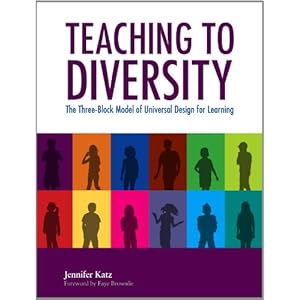
Teaching to Diversity Cover. (Accessed 2014). Uploaded to Amazon; Portage& Main Press.
Available online at: http://www.amazon.ca/Teaching-Diversity-Three-Block-Universal-Learning/dp/1553793536
- Students need to feel comfortable and safe in the classroom environment
in order to be socially and emotionally prepared to learn
- A child that is stressed, or uncomfortable/threatened, will not be able to
effectively concentrate an absorb/apply new information
- Teaching to the Heart and Mind
- Gifted students may experience higher levels of anxiety while at school
do to the high amount of connections their brain makes when looking at
information
- Recognize that social and emotional learning is not necessarily linked
to economic status, home situations, peer groups, etc
* Case Study - Micheal (chains)
- Multiple Intelligences and Social and Emotional Learning
- Do not stereotype or label children based off of prior knowledge alone
- Children need to know that their life has meaning, they are valued, and
that they have something to contribute to the world
- Gardner's Theory of Multiple Intelligences factors in two social and
emotional areas: Interpersonal and Intrapersonal
- Inter: social awareness and respect for others
- Intra: self-awareness and self-respect
The Respecting Diversity Program
- Program implemented into schools that increases self-respect and respect
for others
- Help students recognize their individual strengths
- Introducing Multiple Intelligences to Students
- Demystify the idea of multiple intelligences and educate students so that
they have a platform and understanding of vocabulary and concepts in
order to understand
- Specific time is set aside to discuss and explore this idea so that each
student understands where they fit in this idea
- Script for Respecting Diversity Program
- Includes 9 lessons to introduce multiple intelligences to students
* Case Study - Derrick (sports impulses)
Extending the Program across the Curriculum
- Use multiple intelligence language in other curricula activities to reinforce
concepts and diversity
1 ) Language Arts/English
- Theatre (bodily/kinesthetic)
- Write songs (musical)
- Book clubs (interpersonal)
- etc
2 ) Math
- Provide manipulatives (bodily/kinesthetic)
- Word problems (linguistic)
- Create visual examples (visual spatial)
- etc
3 ) Science/Social Studies
- Build models (bodily/kinesthetic)
- Create experiments (logical, intra-personal)
- Environmental studies (naturalist)
- etc
- Include social curriculum into your regular class, as well as academic
curriculum
- hold weekly meetings
- talk about goal setting
- have students reflect on their learning
- RD Program Outcomes
- Students were interviewed and shared that they felt more self-aware
and confident about who they were as learners
- Students felt that they understood their peers better and found it easier
to put themselves in their shoes when someone was experiencing
challenges
- Reduction in teasing
- Strengthened sense of community
* Case Study - Jay (dyslexia)
- Spirit Buddies
- Some students start the day having no connections with peers, adults,
etc and are left with no positive interactions and a sense of isolation
- Set aside time each morning for students, in small groups, to meet,
share, and use active listening
Creating Democratic Classrooms
- Involve students and provide them with choice
- Five Characteristics of a Democratic Classroom
1 ) Teachers & students work collaboratively to ensure students'
learning contributes positively to the community
- Service projects
2 ) Students demonstrate learning outside of the classroom &
receive public feedback
- Presentations to others, parents, etc
3 ) Students are provided with choice (individual and group)
- Scheduling, format, representation, etc
4 ) Students are presented with a problem-solving approach
to learning
5 ) Students are held to a high degree of excellence
- Seven Principles of a Democratic Classroom
1 ) Social is as important as academic
2 ) How you learn is as important as what you learn
3 ) Cognitive growth occurs with social interaction
4 ) Children require a set of social skills in order to be successful
- Cooperation, self-control, responsibility, etc
5 ) Knowing our students as individuals is as important as what
we teach them
6 ) Knowing our students' families is vital
7 ) How a school staff functions together is as important as
individual competence
- Six Teaching Strategies in Democratic Classrooms
1 ) Class Meetings
2 ) Rules & Logical Consequences
3 ) Guided Discovery
4 ) Academic Choice
5 ) Classroom Organization
6 ) Family Communication Strategies
* Case Study - Melissa (rock throwing)
- Class Meetings
- Should be weekly but students can call a meeting when needed
- Strengthens community and ensures that students know the
classroom is a safe place where issues are solved together for
the good of everyone
* Case Study - Jason (my name)
_____________________________________________
I WANT TO KNOW:
Have you used the formal Respect for Diversity program in your classroom?
I have discussed multiple intelligences with my students and had them fill out surveys and reflect on their type of intelligence, but it has never been to the extent of this program.
Please leave your thoughts below :)







.JPG)
.JPG)

.JPG)

.JPG)
.JPG)


